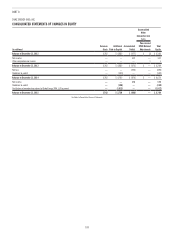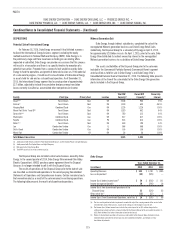Duke Energy 2015 Annual Report Download - page 128
Download and view the complete annual report
Please find page 128 of the 2015 Duke Energy annual report below. You can navigate through the pages in the report by either clicking on the pages listed below, or by using the keyword search tool below to find specific information within the annual report.
108
PART II
DUKE ENERGY CORPORATION • DUKE ENERGY CAROLINAS, LLC • PROGRESS ENERGY, INC. •
DUKE ENERGY PROGRESS, LLC. • DUKE ENERGY FLORIDA, LLC. • DUKE ENERGY OHIO, INC. • DUKE ENERGY INDIANA, INC.
Combined Notes to Consolidated Financial Statements – (Continued)
SIGNIFICANT ACCOUNTING POLICIES
Use of Estimates
In preparing financial statements that conform to generally accepted
accounting principles (GAAP) in the U.S., the Duke Energy Registrants must
make estimates and assumptions that affect the reported amounts of assets
and liabilities, the reported amounts of revenues and expenses and the
disclosure of contingent assets and liabilities at the date of the financial
statements. Actual results could differ from those estimates.
Regulatory Accounting
The majority of the Duke Energy Registrants’ operations are subject to
price regulation for the sale of electricity and gas by state utility commissions
or FERC. When prices are set on the basis of specific costs of the regulated
operations and an effective franchise is in place such that sufficient gas or
electric services can be sold to recover those costs, the Duke Energy Registrants
apply regulatory accounting. Regulatory accounting changes the timing of the
recognition of costs or revenues relative to a company that does not apply
regulatory accounting. As a result, Regulatory assets and Regulatory liabilities
are recognized on the Consolidated Balance Sheets. Regulatory assets and
liabilities are amortized consistent with the treatment of the related cost in the
ratemaking process. See Note 4 for further information.
Regulatory accounting rules also require recognition of a disallowance
(also called “impairment”) loss if it becomes probable that part of the cost
of a plant under construction (or a recently completed plant or an abandoned
plant) will be disallowed for ratemaking purposes and a reasonable estimate of
the amount of the disallowance can be made. Other disallowances can require
judgments on allowed future rate recovery.
When it becomes probable that regulated generation, transmission or
distribution assets will be abandoned, the cost of the asset is removed from
plant in service. The value that may be retained as a regulatory asset on the
balance sheet for the abandoned property is dependent upon amounts that
may be recovered through regulated rates, including any return. As such, an
impairment charge could be offset by the establishment of a regulatory asset
if rate recovery is probable. The impairment for a disallowance of costs for
regulated plants under construction, recently completed or abandoned is based
on discounted cash flows.
Regulated Fuel Costs and Purchased Power
The Duke Energy Registrants utilize cost-tracking mechanisms, commonly
referred to as fuel adjustment clauses. These clauses allow for the recovery
of fuel and fuel-related costs and portions of purchased power costs through
surcharges on customer rates. The difference between the costs incurred
and the surcharge revenues is recorded either as an adjustment to Operating
Revenues – Regulated electric or Operating Expenses – Fuel used in electric
generation on the Consolidated Statements of Operations with an off-setting
impact on regulatory assets or liabilities.
Cash and Cash Equivalents
All highly liquid investments with maturities of three months or less
at the date of acquisition are considered cash equivalents. At December 31,
2015, $534 million of Duke Energy’s total cash and cash equivalents is held
by entities domiciled in foreign jurisdictions. During the fourth quarter of 2014,
Duke Energy declared a taxable dividend of historical foreign earnings in the
form of notes payable that will result in the repatriation of approximately $2.7
billion in cash held and expected to be generated by International Energy over
a period of up to eight years. Approximately $1.5 billion was remitted in 2015.
See Note 22 to the Consolidated Financial Statements, “Income Taxes,” for
additional information.
Restricted Cash
The Duke Energy Registrants have restricted cash related primarily
to collateral assets, escrow deposits and variable interest entities (VIEs).
Restricted cash balances are reflected in Other within Current Assets and in
Other within Investments and Other Assets on the Consolidated Balance
Sheets. At December 31, 2015 and 2014, Duke Energy had restricted cash
totaling $108 million and $298 million, respectively.
Inventory
Inventory is used for operations and is recorded primarily using the average cost method. Inventory related to regulated operations is valued at historical
cost. Inventory related to nonregulated operations is valued at the lower of cost or market. Materials and supplies are recorded as inventory when purchased and
subsequently charged to expense or capitalized to property, plant and equipment when installed. Reserves are established for excess and obsolete inventory. Inventory
reserves were not material at December 31, 2015 and 2014. The components of inventory are presented in the tables below.
December 31, 2015
(in millions)
Duke
Energy
Duke
Energy
Carolinas
Progress
Energy
Duke
Energy
Progress
Duke
Energy
Florida
Duke
Energy
Ohio
Duke
Energy
Indiana
Materials and supplies $ 2,389 $ 785 $ 1,133 $ 776 $ 357 $ 81 $ 301
Coal held for electric generation 1,114 451 370 192 178 16 267
Oil, gas and other fuel held for electric generation 307 40 248 120 128 8 2
Total inventory $ 3,810 $ 1,276 $ 1,751 $ 1,088 $ 663 $ 105 $ 570
























